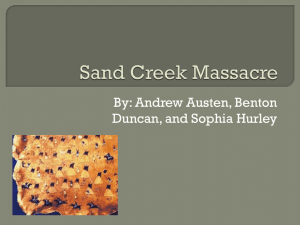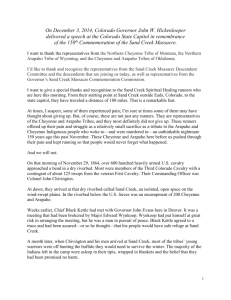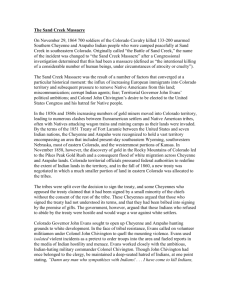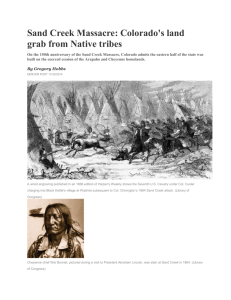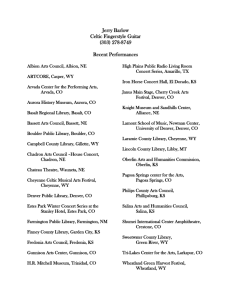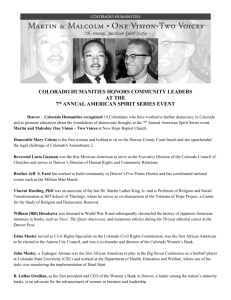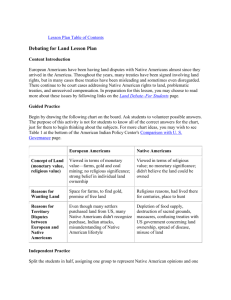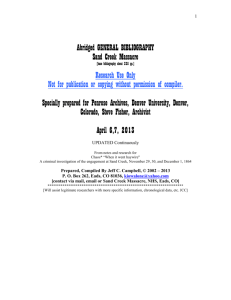Colorado sites related to the Cheyenne and
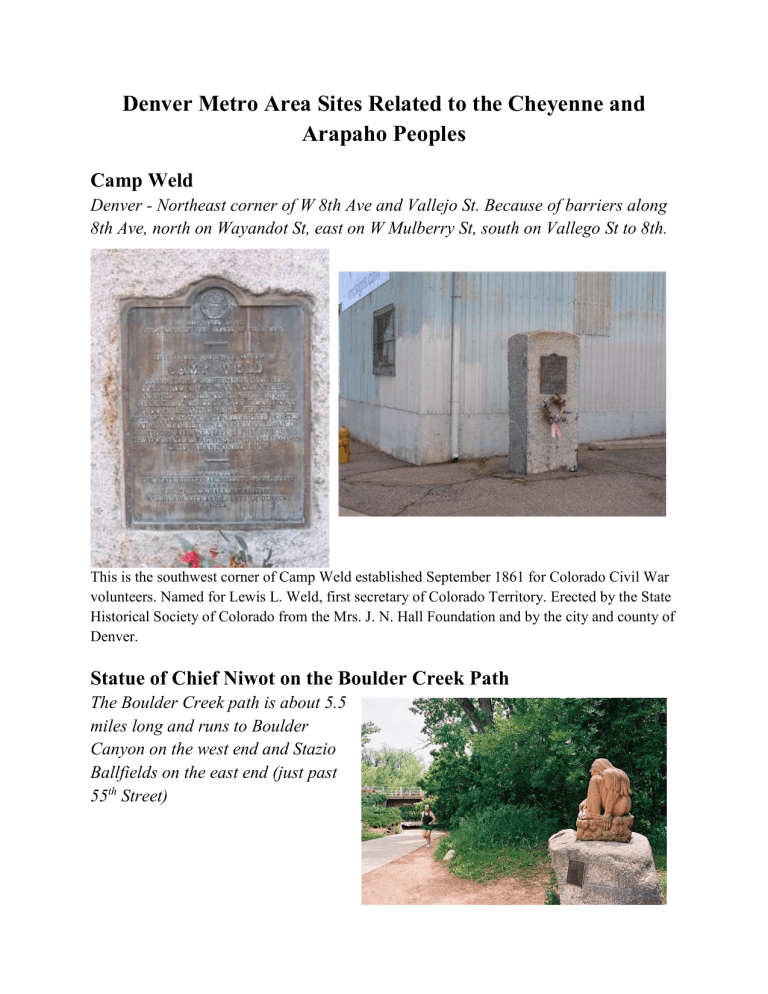
Denver Metro Area Sites Related to the Cheyenne and
Arapaho Peoples
Camp Weld
Denver - Northeast corner of W 8th Ave and Vallejo St. Because of barriers along
8th Ave, north on Wayandot St, east on W Mulberry St, south on Vallego St to 8th.
This is the southwest corner of Camp Weld established September 1861 for Colorado Civil War volunteers. Named for Lewis L. Weld, first secretary of Colorado Territory. Erected by the State
Historical Society of Colorado from the Mrs. J. N. Hall Foundation and by the city and county of
Denver.
Statue of Chief Niwot on the Boulder Creek Path
The Boulder Creek path is about 5.5 miles long and runs to Boulder
Canyon on the west end and Stazio
Ballfields on the east end (just past
55 th Street)
Statue of Southern Arapaho Chief Niwot
Outside the Boulder County Courthouse
(1777 6th St, Boulder, CO 80302)
Memorial Marker for Captain Silas Soule
On side of building on the corner of Fifteenth and
Arapaho in Denver, Colorado
This memorial marks the spot where Soule was assassinated several months after testifying against his former commander, John Chivington, about the Sand Creek
Massacre.
The plaque, dedicated in November 2010, reads: “Silas S.
Soule. At this location on April 23, 1865, assassins shot and killed 1 st Colorado Cavalry officer Capt. Silas S. Soule.
During the infamous Sand Creek Massacre of November 29,
1864, Soule had disobeyed orders by refusing to fire on Chief
Black Kettle’s peaceful Cheyenne and Arapaho village.
Later, at army hearings, Soule testified against his commander, Col. John M. Chivington, detailing the atrocities committed by the troops at Sand Creek. His murderers were never brought to justice.”
Captain Silas Soule’s Grave and Territorial Governor John Evans’s
Grave
Riverside Cemetery (5201 Brighton Blvd, Denver, CO 80216)
Sand Creek Interpretive Plaque
Near the Civil War monument outside the west steps of the Colorado State Capitol
(200 E Colfax Ave,
Denver, CO 80203)
In 1999, the Colorado Senate
Joint Resolution 99-017 authorized the placement of
“an interpretive sign or memorial for permanent display on the capitol grounds that would explain the historic significance of the Sand Creek Massacre to
Colorado and the United
States.” The plaque is placed next to the Civil War
monument that labels the Sand Creek Massacre as a battle. The controversy surrounding this
Civil War Monument has become a symbol of Coloradans' struggle to understand and take responsibility for the past.
Fremont’s Orchard
On Bijou Creek near Fort Morgan
Fremont’s Orchard is a site of a key skirmish between Colorado soldiers and Cheyenne warriors in April 1864. More information here
Huntgate Massacre Site
On Box Elder Creek near Elizabeth, Colorado, in Elbert County
“Often given as a cause for the savagery of the massacre on Sand Creek, the murder of the
Hungate Family forms one of the mysteries of
1864's sordid history. Nathan (29 years), Ellen
(25), Laura (2 ½) and Florence (under 6 mos.)
Hungate were killed along Running or Box Elder
Creek at or near the cabin of their employer,
Isaac P. Van Wormer.
Killed about 25 miles southeast of downtown
Denver at about noon on June 11, 1864, the young family had only been in the territory about three months. The bodies were exhumed and brought to Denver on June 13, where they were publicly displayed, inciting the citizens and heightening the paranoia about impending Indian attacks.
Although many speculated about suspects in the murders, a single individual or group has never been identified to a reasonable certainty. Many Coloradans blamed the Cheyenne or Arapaho, as reflected in the Coroner's inquest on June 14. It stated that the family, "... came to their death by being feloniously killed by some person or persons to the jury unknown, but supposed to be
Indians[.]"
However, even experienced frontiersman Jim Beckwourth doubted the family had been killed by either the Cheyenne or Arapaho because of the manner of death, according to the June 15th
Daily Commonwealth. After four burials and three exhumations, their remains finally came to rest at Denver's Fairmount Cemetery in late July 1892.” – Jeff Campbell, National Park Service,
News Release on 6/2/14
Julesburg, Colorado
Julesburg is the site of retaliatory attacks by Cheyenne, Arapaho, and Lakota warriors in early
1865. According to Rocky Mountain PBS, American Experience Article , “retribution [for the
Sand Creek Massacre] fell 39 days later upon the frontier town of Julesburg, Colorado. An assembly of 1,000 Sioux, Arapaho, and Northern Cheyenne -- survivors of Sand Creek among them -- overran the town, killing civilians and soldiers and distributing their body parts across the countryside. They continued through Platte Valley, destroying stage stations and telegraph wires, effectively halting transcontinental communication. Later, the party returned to Julesburg and burned it to the ground.”
Fort Lyon, Colorado
Southeastern Colorado, between the municipalities of Las Animas and Lamar
Fort Lyon was the nearest fort to the site of the Sand Creek Massacre
Native American Wheel Sculpture
Denver Art Museum (100 W 14th Ave Pkwy, Denver, CO 80204)
In 1996, after soliciting proposals from nine American Indian artists, the Denver Art Museum commissioned HOCK E AYE VI Edgar Heap of Birds to create a work of art for the site in front of the North Building. The sculpture was dedicated on June 21, 2005.
Wheel consists of ten red, forked tree forms made of porcelain enameled panels on steel frames.
Each tree is twelve feet high and positioned on a fifty-foot diameter circle.
Wheel is aligned to the summer solstice sunrise;
Trees One and Ten form an opening to the east. Visit the sculpture at sunrise on
June 21, stand at Tree Six and the sun will rise between Tree One and Tree
Ten.
Wheel specifically addresses the history of
Indian peoples from Heap of Birds’ perspective as a
Cheyenne/Arapaho artist, whose ancestors have a long and often painful history in the region — as well as from the multiple tribes who have lived in Colorado for centuries. The Cheyenne phrase “NAH-KEV-HO-EYEA-ZIM” which is on the curved wall in the background, translates to “We are always returning back home again.”
The artist reveals his perspective of the events of history through the use of words and images.
His goal for this work of art is to stimulate discussion by exploring new perspectives on
American history while offering an optimistic future for Native people.
Wheel was composed to welcome you.
Walk inside the circle.
Walk around each tree to find something that you recognize.
Explore the symbolism of each picture or phrase on the trees.
Please, take the time to visit and enjoy Wheel.
For additional information about this sculpture please contact: Nancy Blomberg, Curator of
Native Arts, Denver Art Museum
Bent’s Old Fort National Historic Site, National Park Service
Otero County - 35110 Colorado 194, La Junta, Colorado
Bent's Old Fort National Historic Site features a reconstructed 1840s adobe fur trading post on the mountain branch of the Santa Fe Trail where traders, trappers, travelers, and the Cheyenne and Arapaho tribes came together in peaceful terms for trade. Today, living historians recreate the sights, sounds, and smells of the past with guided tours, demonstrations and special events.
